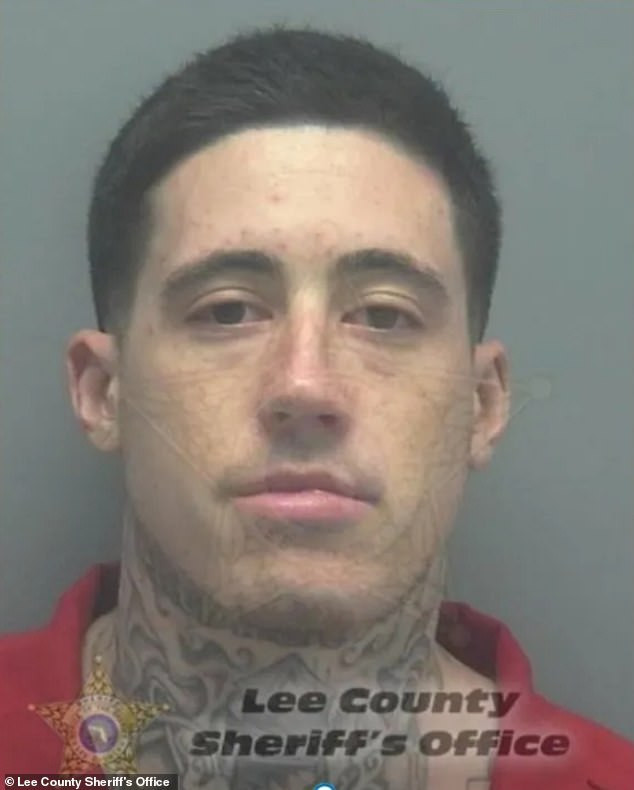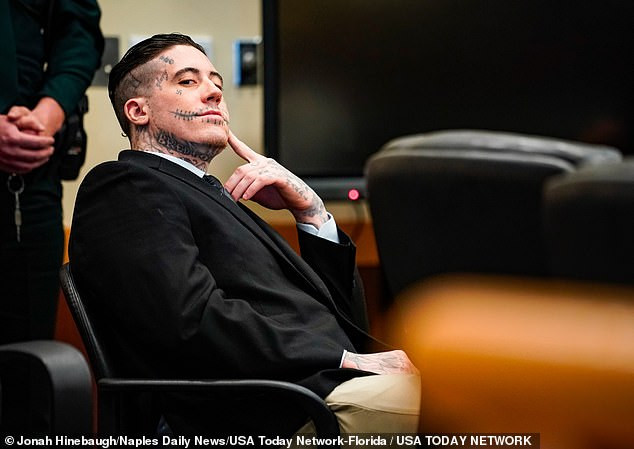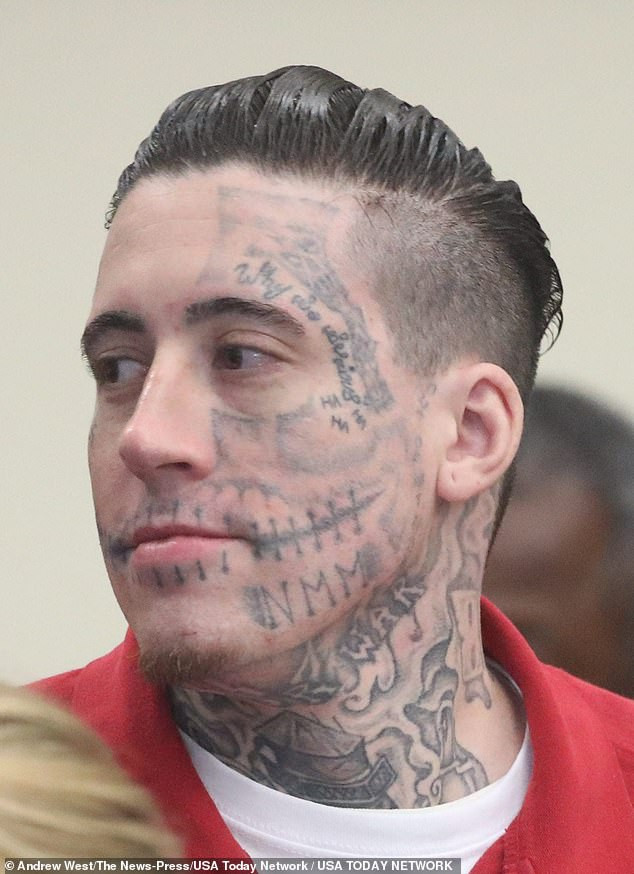The question “When Did Wade Wilson Get His Tattoos?” is a complex one, intertwined with his disturbing crimes and transformation. At tattooat.com, we delve into the timeline, symbolism, and the chilling story behind Wade Wilson’s white supremacist tattoos, exploring the broader context of prison tattoos and their meanings. We aim to provide insights while emphasizing that tattooat.com does not endorse hate symbols or ideologies; we promote artistic expression and understanding.
The content below will explore the subject of tattoos, prison culture, and the disturbing transformation of Wade Wilson. If you’re seeking tattoo inspiration, artist recommendations, or educational resources on tattoo artistry, tattooat.com is your reliable source. Let’s explore the meanings and history behind tattoos!
1. What is the Timeline of Wade Wilson’s Tattoos?
Wade Wilson, infamously dubbed the ‘Deadpool Killer’, showcased a stark transformation between his arrest in 2019 and his sentencing. He acquired a significant array of white supremacist tattoos while in custody awaiting trial, despite this violating prison policies. His lawyer, Kevin Shirley, mentioned that Wilson never clarified why he chose to alter his appearance in this way.
 Wade Wilson showcasing visible face tattoos during a court appearance
Wade Wilson showcasing visible face tattoos during a court appearance
2. What Tattoos Did Wade Wilson Have at the Time of His Arrest?
At the time of his arrest in 2019 for the murders of Kristine Melton and Diane Ruiz, Wade Wilson had tattoos on his neck and arms. However, his face was completely clear of any markings. The hateful symbols that would later adorn his face were acquired while he was incarcerated.
 Wade Wilson pictured at the time of his arrest in 2019 without any face tattoos
Wade Wilson pictured at the time of his arrest in 2019 without any face tattoos
3. What are the Prominent Tattoos on Wade Wilson’s Face?
Wade Wilson’s face is covered in several prominent tattoos, each carrying hateful and violent meanings:
-
Swastikas: Multiple swastikas, symbols of Adolf Hitler’s Nazi party, are visible across his face and head.
-
The Number 14: Located on the right side of his neck, this represents the white supremacist mantra, “We must secure the existence of our people and a future for white children.”
-
The Number 88: Found on the left side of his neck, this numeric code stands for “Heil Hitler.”
-
TTG: Across his forehead, this stands for “Time To Go” or “Trained To Go,” indicating a readiness for violence.
-
Bred for War: Underneath his chin, these words reflect his willingness to engage in violence.
-
Why so serious: On the left side of his face, a skeletal figure says, “Why so serious,” referencing Heath Ledger’s portrayal of the Joker in The Dark Knight.
Christopher Magyarics, an Anti-Defamation League Research Fellow, noted that these tattoos, while not directly linking him to a specific gang, suggest his involvement with the white supremacist prison gang The Unforgiven during his time in Lee County Jail.
4. What is the Significance of White Supremacist Tattoos?
White supremacist tattoos carry significant weight as symbols of hate and violence. According to the Anti-Defamation League (ADL), these symbols represent anti-Semitism, white supremacy, and a commitment to racist ideologies. Tattoos like swastikas, the number 14, and the number 88 are commonly used by white supremacists to identify themselves and promote their hateful beliefs.
 Close up of Wade Wilson's face showing Swastika tattoo linked to Adolf Hitler's Nazi party
Close up of Wade Wilson's face showing Swastika tattoo linked to Adolf Hitler's Nazi party
5. How Do Prisons Enable the Proliferation of Tattoos?
Despite prison policies forbidding tattoos, inmates often find ways to create makeshift tattoo guns and use materials like ink from pens or melted plastic to create tattoos. The reasons behind this vary. In Wilson’s case, it was to align himself with a white supremacist gang, to show that he belonged to The Unforgiven.
6. What Role Do Tattoos Play in Prison Culture?
Tattoos play a significant role in prison culture, serving multiple purposes:
- Identification: Tattoos can signify gang affiliation, criminal history, or status within the prison hierarchy.
- Protection: Inmates may get tattoos to appear tougher and deter potential attackers.
- Remembrance: Tattoos can commemorate loved ones, significant events, or lost comrades.
- Rebellion: Defying prison rules by getting tattoos can be an act of rebellion against the system.
- Transformation: Tattoos can represent a personal transformation or a commitment to a new identity.
7. How do White Supremacist Groups Use Tattoos?
White supremacist groups use tattoos as a means of identification and communication. These tattoos serve to visually align individuals with a specific ideology and signal their commitment to the group’s beliefs. According to a study by Portland State University’s Sociology Department in March 2023, white supremacist tattoos help solidify group identity and create a sense of belonging among members.
Here’s a breakdown of how these groups utilize tattoos:
- Symbolism: Tattoos often incorporate symbols and imagery specific to white supremacist ideologies, such as swastikas, Celtic crosses, and runes.
- Messaging: Tattoos may display slogans, phrases, or numbers that convey specific messages and beliefs, such as “1488” or “White Pride.”
- Recruitment: Tattoos can serve as a visual advertisement for the group, attracting potential recruits who share similar beliefs or values.
- Intimidation: Tattoos can be used to intimidate rivals, law enforcement, or anyone perceived as a threat to the group’s agenda.
- Commitment: By permanently marking their bodies with white supremacist symbols, individuals demonstrate their unwavering commitment to the group’s cause.
8. What is the Significance of “Why So Serious” Tattoo?
The “Why so serious” tattoo on Wade Wilson’s face references Heath Ledger’s portrayal of the Joker in Christopher Nolan’s 2008 film, The Dark Knight. In the film, the Joker uses this phrase to taunt his victims and justify his violent actions. The phrase is often associated with chaos, nihilism, and a disregard for social norms.
 Close up of Wade Wilson's face showing skeletal figure tattoo saying the words 'Why so serious'
Close up of Wade Wilson's face showing skeletal figure tattoo saying the words 'Why so serious'
In the context of Wade Wilson’s tattoos, the “Why so serious” tattoo may represent his embrace of violence, his rejection of societal norms, and his desire to instill fear in others.
9. How Do Law Enforcement Agencies Track Tattoos?
Law enforcement agencies often track tattoos as a means of identifying individuals, associating them with criminal activity, and gathering intelligence on gangs and other organized groups. According to the FBI’s National Gang Intelligence Center, tattoos can provide valuable information about an individual’s affiliations, beliefs, and criminal history.
Here are some ways law enforcement agencies track tattoos:
- Documentation: Law enforcement agencies document tattoos during booking and intake processes, including photographs and written descriptions.
- Databases: Tattoos are often entered into law enforcement databases, allowing officers to search for individuals based on their tattoos.
- Expert Analysis: Law enforcement agencies may consult with tattoo experts to interpret the meaning and significance of tattoos.
- Surveillance: Tattoos can be used to identify individuals during surveillance operations and investigations.
- Intelligence Gathering: Law enforcement agencies gather intelligence on tattoos associated with specific gangs, criminal groups, and extremist organizations.
10. What Are the Ethical Considerations of Displaying Hate Symbols as Tattoos?
The display of hate symbols as tattoos raises significant ethical concerns, as these symbols can perpetuate violence, discrimination, and hatred.
Here are some ethical considerations to keep in mind:
- Freedom of Expression: While individuals have the right to express themselves, this right is not absolute and does not extend to hate speech or incitement to violence.
- Responsibility: Tattoo artists have a responsibility to consider the potential impact of their work and avoid creating tattoos that promote hate or discrimination.
- Impact on Victims: Hate symbols can cause deep emotional distress and trauma to victims of hate crimes and discrimination.
- Social Consequences: The display of hate symbols can normalize hateful ideologies and contribute to a climate of fear and intolerance.
- Education and Awareness: It is important to educate individuals about the meaning and impact of hate symbols and promote awareness of the harm they can cause.
11. What is the Impact of Wade Wilson’s Tattoos on His Trial?
Wade Wilson’s tattoos likely had a significant impact on his trial, influencing the jury’s perception of him and reinforcing the image of a violent and remorseless killer. The hateful symbols displayed on his face served as a constant reminder of his white supremacist beliefs and his propensity for violence.
Here are some ways Wade Wilson’s tattoos may have impacted his trial:
- Prejudice: The tattoos may have prejudiced the jury against Wilson, making them more likely to believe he was guilty of the crimes he was accused of.
- Aggravating Factor: The tattoos may have been considered an aggravating factor during sentencing, leading the jury to recommend the death penalty.
- Lack of Remorse: The tattoos may have conveyed a lack of remorse for his crimes, further alienating the jury and reinforcing the image of a cold-blooded killer.
- Public Perception: The tattoos may have influenced public perception of the trial, generating outrage and calls for justice.
12. How Do Tattoos Reflect Personal Transformation?
Tattoos can serve as powerful symbols of personal transformation, marking significant life events, overcoming challenges, or embracing new identities. According to a study by the University of Texas at Austin’s Department of Psychology in July 2024, tattoos can help individuals heal from trauma, build self-esteem, and express their authentic selves.
Here are some ways tattoos can reflect personal transformation:
- Commemoration: Tattoos can commemorate significant life events, such as overcoming addiction, surviving a serious illness, or achieving a personal goal.
- Healing: Tattoos can help individuals heal from trauma by providing a sense of closure, reclaiming control over their bodies, and expressing their emotions.
- Self-Expression: Tattoos can be a form of self-expression, allowing individuals to communicate their values, beliefs, and identities to the world.
- Empowerment: Tattoos can empower individuals by giving them a sense of control over their bodies and their lives.
- Identity: Tattoos can help individuals embrace new identities by visually representing their transformation and their commitment to change.
13. How Have Media Outlets Covered Wade Wilson’s Tattoos?
Media outlets have widely covered Wade Wilson’s tattoos, often focusing on their hateful and violent symbolism. These tattoos have been used to illustrate Wilson’s transformation into a white supremacist and to condemn his heinous crimes. News articles, television reports, and social media posts have all featured images of Wilson’s tattoos, sparking outrage and condemnation.
Here are some common themes in media coverage of Wade Wilson’s tattoos:
- Condemnation: Media outlets have universally condemned Wilson’s tattoos as symbols of hate and violence.
- Shock: Many media outlets have expressed shock and disbelief at the extent of Wilson’s transformation and the hateful nature of his tattoos.
- Context: Some media outlets have provided context on the meaning and significance of Wilson’s tattoos, explaining their connection to white supremacist ideologies.
- Public Reaction: Media outlets have reported on public reaction to Wilson’s tattoos, including outrage, condemnation, and calls for justice.
14. What are Some Examples of Positive Transformations Through Tattoos?
While Wade Wilson’s tattoos represent a disturbing transformation, tattoos can also be used to mark positive changes and personal growth. Here are some examples of positive transformations through tattoos:
- Cancer Survivors: Many cancer survivors get tattoos to commemorate their journey, celebrate their survival, and reclaim their bodies.
- Addiction Recovery: Individuals recovering from addiction may get tattoos to symbolize their sobriety, their commitment to recovery, and their newfound strength.
- Overcoming Trauma: Survivors of trauma may get tattoos to heal from their experiences, reclaim control over their bodies, and express their resilience.
- Gender Affirmation: Transgender individuals may get tattoos to affirm their gender identity, express their true selves, and celebrate their journey of self-discovery.
- Personal Milestones: Individuals may get tattoos to commemorate personal milestones, such as graduating from college, starting a new career, or achieving a personal goal.
15. What Resources Are Available for Understanding Tattoo Symbolism?
Several resources are available for understanding tattoo symbolism, including books, websites, and expert consultations. These resources can help individuals decipher the meaning and significance of tattoos, whether they are considering getting a tattoo themselves or simply curious about the art form.
Here are some examples of resources for understanding tattoo symbolism:
- Books: Several books explore the history, meaning, and symbolism of tattoos, providing insights into different styles, motifs, and cultural traditions.
- Websites: Numerous websites offer information on tattoo symbolism, including dictionaries of tattoo meanings, articles on tattoo history, and forums where people can discuss their tattoos.
- Tattoo Artists: Experienced tattoo artists can often provide insights into the meaning and symbolism of tattoos, drawing on their knowledge of tattoo history, culture, and traditions.
- Cultural Experts: Cultural experts, such as anthropologists, historians, and folklorists, can provide insights into the cultural significance of tattoos in different societies and traditions.
16. What Should Individuals Consider Before Getting Tattoos with Potentially Offensive Symbolism?
Before getting tattoos with potentially offensive symbolism, individuals should carefully consider the potential impact of their tattoos on themselves, others, and society as a whole. Tattoos are permanent, and they can have lasting consequences, both positive and negative.
Here are some factors individuals should consider:
- Meaning: Understand the meaning and significance of the symbols you are considering, and make sure you are comfortable with their potential implications.
- Impact: Consider how your tattoos may be perceived by others, and whether they could be seen as offensive, hateful, or discriminatory.
- Consequences: Be aware of the potential consequences of getting tattoos with offensive symbolism, including social stigma, discrimination, and even legal repercussions.
- Alternatives: Explore alternative designs or symbols that convey your message without causing harm or offense to others.
- Consultation: Talk to tattoo artists, cultural experts, and members of your community to get feedback on your tattoo ideas and ensure that you are making an informed decision.
17. What is Tattooat.com’s Stance on Hate Symbols in Tattoos?
Tattooat.com strongly condemns hate symbols in tattoos and does not endorse or promote any form of hate speech, discrimination, or violence. We believe that tattoos should be used to express positive values, celebrate diversity, and promote understanding and respect among all people.
We are committed to providing a safe and inclusive platform for tattoo enthusiasts, artists, and anyone interested in learning about the art form. We reserve the right to remove any content that promotes hate, discrimination, or violence, and we will not hesitate to ban users who violate our community guidelines.
18. Where Can I Find Safe and Ethical Tattoo Artists?
Finding safe and ethical tattoo artists is essential to ensure a positive and responsible tattooing experience. Look for artists who prioritize hygiene, follow industry best practices, and respect the diverse backgrounds and beliefs of their clients.
Here are some resources for finding safe and ethical tattoo artists:
- Online Directories: Websites like Tattooat.com offer directories of tattoo artists, allowing you to search for artists based on location, style, and specialties.
- Recommendations: Ask friends, family, or members of your community for recommendations of tattoo artists they trust and respect.
- Studio Visits: Visit tattoo studios in person to assess their hygiene practices, artist portfolios, and overall atmosphere.
- Social Media: Explore tattoo artists’ social media profiles to see examples of their work, read reviews, and get a sense of their values and ethics.
- Professional Organizations: Consult with professional organizations like the Alliance of Professional Tattooists to find certified and reputable tattoo artists in your area.
19. What Are the Latest Trends in Tattoo Art?
The world of tattoo art is constantly evolving, with new styles, techniques, and trends emerging all the time. Staying up-to-date on the latest trends can help you find inspiration for your next tattoo and connect with artists who are pushing the boundaries of the art form.
Here are some of the latest trends in tattoo art:
| Trend | Description |
|---|---|
| Fine Line Tattoos | Delicate and intricate designs created with thin lines and minimal shading, often featuring geometric patterns, floral motifs, or script. |
| Watercolor Tattoos | Soft and ethereal designs that mimic the look of watercolor paintings, with vibrant colors, blurred edges, and a dreamy aesthetic. |
| Blackout Tattoos | Large areas of solid black ink used to cover up unwanted tattoos or create bold and striking graphic designs. |
| Geometric Tattoos | Precise and symmetrical designs created with geometric shapes, lines, and patterns, often incorporating sacred geometry or mathematical concepts. |
| Botanical Tattoos | Designs inspired by nature, featuring flowers, leaves, trees, and other botanical elements, often rendered in realistic or stylized styles. |
20. How Can I Share My Tattoo Story on Tattooat.com?
Tattooat.com welcomes tattoo enthusiasts from all walks of life to share their stories, experiences, and perspectives on the art form. Whether you have a personal story to tell, a unique tattoo design to showcase, or insights to share on tattoo culture, we invite you to contribute to our community.
Here are some ways you can share your tattoo story on Tattooat.com:
- Submit an Article: Write a blog post or article about your tattoo story, and submit it to our editorial team for review.
- Share Photos: Share photos of your tattoos on our social media channels, and tag us in your posts so we can feature them on our page.
- Participate in Discussions: Join our online forums and discussion groups to share your thoughts, ask questions, and connect with other tattoo enthusiasts.
- Attend Events: Attend tattoo conventions, art shows, and other events in your area, and share your experiences with our community.
At tattooat.com, we believe that everyone has a story to tell, and we are committed to providing a platform for diverse voices and perspectives within the tattoo community. Contact us at +1 (503) 725-3000 or visit our address at 1825 SW Broadway, Portland, OR 97201, United States. You can also check our website at tattooat.com
FAQ: Wade Wilson’s Tattoos
1. Why Did Wade Wilson Get Tattoos in Prison?
Wade Wilson’s lawyer stated he never expressed his reasons, but the tattoos acquired in prison are linked to white supremacist ideology and gang affiliation, specifically The Unforgiven.
2. Are Tattoos Allowed in Florida Prisons?
No, tattooing is against prison policies in Florida. However, inmates often find ways to create makeshift tattoo guns and use unauthorized materials.
3. What is the Meaning of the “1488” Tattoo?
“1488” is a combination of two white supremacist symbols: “14” represents the “14 Words” mantra, and “88” is a numeric code for “Heil Hitler.”
4. How Can Tattoos Be Used to Identify Gang Members?
Tattoos can indicate gang affiliation, criminal history, or status within the prison hierarchy, serving as visual identifiers for law enforcement.
5. What Should I Consider Before Getting a Tattoo with Symbolic Meaning?
Consider the tattoo’s meaning, potential impact on others, and whether it aligns with your values before getting inked.
6. Are Tattoos Always Associated with Negative Connotations?
No, tattoos can also represent positive transformations, commemorate milestones, or serve as a form of self-expression.
7. How Can I Find a Tattoo Artist Who Respects My Values?
Research artists’ portfolios, read reviews, and choose someone who aligns with your beliefs and prioritizes ethical practices.
8. What is the Significance of the Swastika Tattoo?
The swastika is a symbol of Adolf Hitler’s Nazi party, representing hate, anti-Semitism, and white supremacy.
9. What Resources Are Available for Understanding Tattoo Symbolism?
Books, websites, and tattoo artists can provide insights into the meaning and history of various tattoo symbols.
10. How Has Media Coverage Influenced Public Perception of Wade Wilson’s Tattoos?
Media coverage has largely condemned Wilson’s tattoos, highlighting their hateful symbolism and the disturbing transformation they represent.
Ready to explore the world of tattoos with a positive and artistic focus? Visit tattooat.com today for endless inspiration, a curated list of talented artists, and informative articles that will guide you through every step of your tattoo journey!
